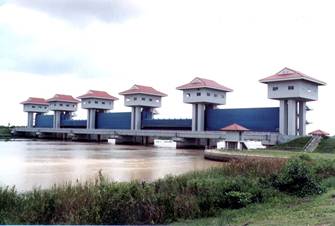The Bang Pakong River is the main river of Chachoengsao province. The Nakhon Nayok River and the Prachin Buri River joins together at the boundary of three provinces, which are Nakhon Nayok province, Prachin Buri province and Chachoengsao province to form the Bang Pakong River. Then it flows to Gulf of Thailand in the area between Amphoe Bang Pakong, Chachoengsao province and Amphoe Muang of Chon Buri province. The outstanding characteristic of this river is the seawater intrusion. As a result, the salinity of the river is fluctuated all the time. The river is brackish around 7-8 months. The maximum intrusion of seawater is in the dry season around April. Such characteristic causes both banks of river to have both fresh water and brackish water ecological systems. Thus, there are diversities in natural resources and ecological systems are productive.
The Royal Irrigation Department (RID), Ministry of Agriculture and Cooperatives has formulated Water Resource Development Plan for Bang Pakong River Basin. A part of this plan is the construction of the Bang Pakong Barrage (Dam) to protect against the intrusion of seawater into the Bang Pakong River and store fresh water for dry season usage. The dam is located on the Right Bank of Bang Pakong River, in the area of Ban Phi Sawek, Tambon Bang Kaew, Amphoe Muang, Chachoengsao province. The construction started in 1996 and finished in 1999. It was operated on January 6, 2000. The dam operation had caused several negative impacts, for example, the river upstream of dam as well as canals flowing into the Bang Pakong River was heavily polluted due to the discharge of wastewater from many activities especially slurry from pig farming, was blocked from discharging into the sea. The other problems are floodings of dam downstream area, which caused the damage of residential houses, agricultural land and products, erosion and collapse of riverbanks and structures along the river downstream of the dam. There were also impacts on tiger prawn farming in the areas upstream of the dam, where farmer previously used seawater from river for shrimp farming, as well as the changes in ecological system, which affect the resident livelihood and their subsistence. From these problems, RID needed to open the dam gates to allow natural water flow.Therefore, in order to be able to fully utilize Bang Pakong Barrage, there is a need to conduct a study to analyze the problems and determine the level of impacts as well as to propose mitigation measures for environmental problems arisen from the dam operation, to efficiently alleviate the impacts and prevent problems in the future.
The study shall comprise the following :
1. Determine status of natural resources, for example, study and survey of natural resources, environmental, ecological system, economic and social conditions of the study area in the past and the present using both primary data and secondary data as well as conduct a study to review results of previous studies conducted by various organizations operating within the Bang Pakong River Basin.
2. Evaluate environmental deterioration caused by operating the Bang Pakong Barrage, level of impact and duration of problems including identify the limit of impacted areas both upstream and downstream of the dam. The main issues as specified hereby shall be addressed as well as additional issues if found any during the study.
3. Analyze and compare expected impacts and benefits gained after project operation. RID’s previous study shall be reviewed to compare the expected impacts and benefits with the actual ones after project operation.
4. Propose appropriate and effective preventive, corrective and mitigate methods and plans for problem/impacts as well as monitoring program for both short and long terms for each problem/impact in the area. The existing plans/projects of each organization shall be considered in the feasibility study. Furthermore, involved organizations and stakeholders within the project area should have an opportunity to participate to propose opinion and suggestion for such plans.
5. Appropriate technology shall be utilized in the study of the conditions of natural resources and environment, the identification of limits of impacted area including the classification of degree of these impacts so that the study results are clearly concluded. Examples of these technology are GIS, Remote Sensing, etc. |














